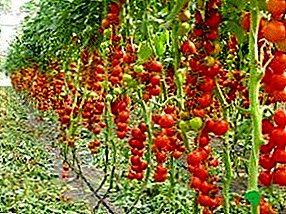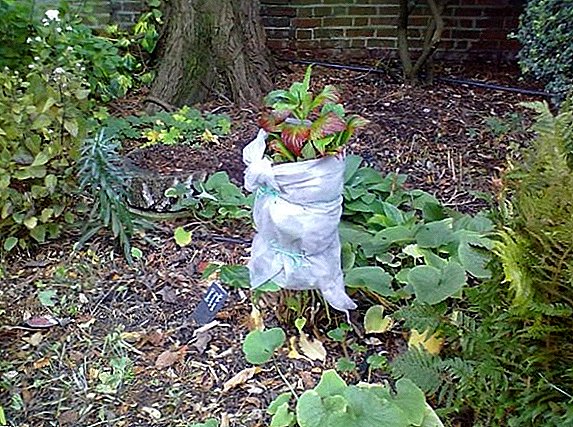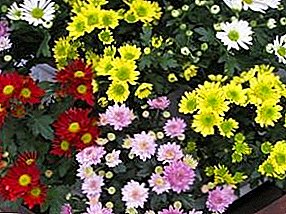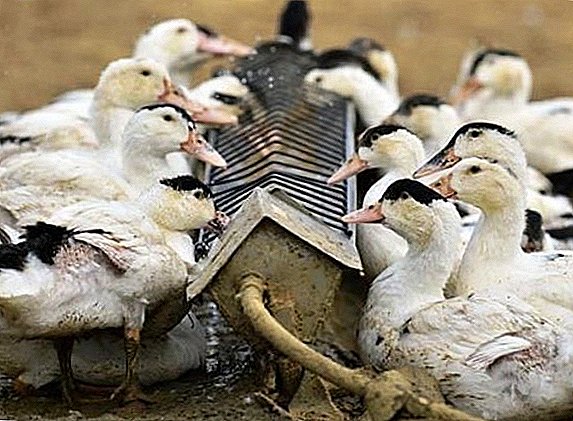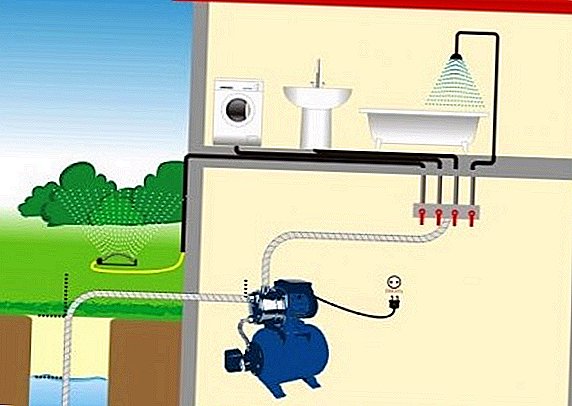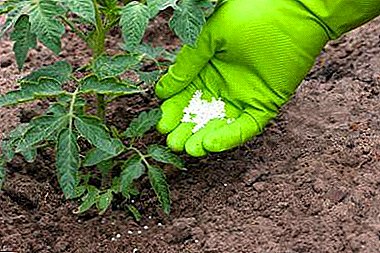
Every gardener dreams that his crop of tomatoes would be the best. To do this, you need to regularly feed tomatoes with various fertilizers. Let's take a closer look at this process, discuss everything that can and cannot be done. The most important is the choice of a suitable fertilizer for tomatoes.
To feed or not to feed tomato seedlings? If fed, what, how and when? How not to harm young sprouts and at the same time grow strong plants? After all, the future harvest depends on it.
If the seedlings do not have enough nutrients, the harvest will be poor and of poor quality. If you overdo it with fertilizers, you can destroy the seedlings. About what to feed, when and how much, as well as warnings from experienced gardeners read on ...
What does this process mean?
Pickling up of a seedling is transplanting young plants from a common tank into larger pots.. This is done at an early stage, when 2-3 true leaves are fully formed.
As in the period of active growth, the seedling begins to require a sufficient amount of soil, nutrients and oxygen. The root system is actively developing, requiring more and more space in the tank.
What happens if you do not dive:
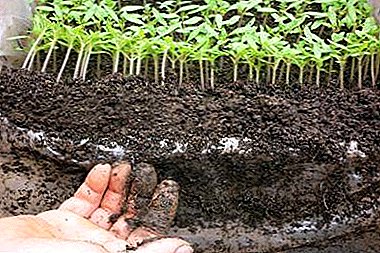 seedlings closely, roots intertwined with each other;
seedlings closely, roots intertwined with each other;- decay lags behind in growth, becomes thinner and weaker;
- there is a lack of oxygen and nutrients;
- poorly developed root system.
Therefore, young shoots increase the area of nutrition by replanting larger pots approximately (500 ml in volume). This gives seedlings a stimulus for the development of the root system and is the key to health. Also, the pick contributes to the development of lateral roots, facilitates the subsequent landing in the ground, helps to select strong plants and get rid of the weak. If necessary, picking will help slow the growth of seedlings.
Next, consider how you can feed the tomatoes before picking, when holding it, or after it, so that the stems of the plants are plump and strong.
We offer you to watch a video on what tomato picking is and how to properly fertilize a plant before transplanting:
How to feed a young plant before transplanting
Is it necessary for tomatoes in the early stages to grow a seedling?
Young seedlings require quite a lot of nutrients.. Since all forces at this time are aimed at growth, the development of the root system and the growth of green mass. A healthy plant can only grow on fertile, fertilized soil. Usually, experts recommend the first feeding after the complete formation of the first true leaf, sometimes a little later.
The number of dressings depends on the quality of the soil into which the seeds are sown, and the soil into which the shoots will be transplanted after picking.
If plants are deficient in nutrients, then it is very easy to notice by the appearance of the shoot.
Signs of deficiency of nutrients:
- Lack of nitrogen is manifested yellowing of the lower tier of the leaves after which they fall. In this case, an excess of nitrogen is manifested by the yellowness of the whole green mass. Urea solution or ammonium nitrate will help here.
- If the plant lacks phosphorus, the lower part of the leaf becomes purple with streaks. To eliminate this problem, use superphosphate (about what are the types of phosphate fertilizers for tomatoes and how to use them, read here).
- With a lack of potassium in the soil, young shoots shrivel and if you do not fight it, the fruits will ripen unevenly.
- With a lack of iron, the plants suffer from chlorosis, yellowing and twisting of the leaves are observed. Iron chelate is perfect here.
Home-made fertilizer recipes
If you decide to feed the seedlings before picking, then the best solution for the first feeding is copper solution. It will reliably protect young shoots from late blight.
For this, 1 tsp concentrate (micronutrient with high copper concentrate) is dissolved in 10 l of water. Then plentifully water shoots. Remains of the solution can be stored as long as necessary.
For subsequent dressings, both chemical compounds and organic fertilizers prepared at home are well suited.
 Recipe number 1:
Recipe number 1:
- 2 liters of water.
- 1 g of urea.
- 8 g of superphosphate.
- 3 g of potassium sulfate.
Recipe number 2:
- 5 g of bread yeast diluted in 5 liters of water.
- Stir well.
- Infuse for 24 hours.
Yeast infusion can not be stored. It is used immediately after preparation.
Learn how to prepare a yeast-based top dressing for tomatoes, as well as the pros and cons of such fertilizer, you can find here.
Recipe number 3:
- 2 liters of water.
- 1 tbsp. spoon wood ash.
Mix and infuse for 24 hours, then strain.
Recipe number 4:
- 2-3 parts of dry banana skins (how to use banana skins and other organic matter for feeding and proper growth of tomatoes, read here).
- 1 part of water.
How to fertilize:
- Before fertilizing the soil should be well moistened.
- The most convenient way of feeding with a syringe, since the plant is still very young and tender.
- Under each bush, it is desirable to bring about 3-5 g of solution from a syringe.
- The second dressing is allowed to be carried out no earlier than two weeks after the first.
At this stage (before the picking) the plants are too young and tender. Here the main thing - do not overdo it!
What fertilizers and when to feed the tomatoes after transplanting?
In order for the seedlings to be plump, and the fruits - large, the correct selection of the composition is necessary for top dressing. Also, regularity and correct procedures are important. Root top dressing is desirable to alternate with foliar fertilizer. In addition, you should follow the rules of procedures.
Root drugs
The first dressing should be made not earlier than 10-14 days after the pick.. The second feeding is made in two weeks. Third - as needed. The last feeding of seedlings is carried out 10 days before planting in the ground.
After the picking, the plant actively increases the green mass, and the following compositions will help in this.
 Recipe number 1:
Recipe number 1:
- 1 tbsp. spoon urea.
- 1l of water.
To mix components before full dissolution and to water plants plentifully. This feeding helps build green mass.
Recipe number 2:
- 1l of water.
- 1 tbsp. spoon fertilizer "Nitrofoska."
Stir the ingredients until completely dissolved and water the seedlings plentifully.
"Nitrophoska" is a mineral fertilizer. The main components - phosphorus, potassium, nitrogen in equal proportions. Available in the form of granules.
Details about the benefits of mineral fertilizers for seedlings and adult tomatoes, as well as the types of dressings and their use, can be found here.
Recipe number 3:
- 1 tsp. Potassium sulphate.
- 1 tbsp. spoon superphosphate.
- 0.5 liters of chicken manure.
- Water -10 l.
Recipe number 4:
- 0.5 liters of liquid mullein.
- 1 tbsp. spoon "Nitrofoski".
- 10 liters of water.
Liquid mullein can be purchased at any store for gardeners and gardeners. As a rule, it is sold in containers of 5 liters. According to the manufacturer, 1 l of such liquid replaces 100 kg of fresh manure. Also in the garden shop you can buy a dry mullein in various packages.
Fertilizers according to recipes 3 and 4 should be added to each bush for 200-300g (approximately half of a 0.5-liter jar).
Foliar formulations for spraying
Foliar application is spraying of plants with special formulations from a sprayer.. This is a great way to fertilize plants during the stages of active growth and with problems with the soil.
The main advantage - the rapid absorption of nutrients. The second advantage is efficiency under adverse weather conditions.
 There is also a minus - difficulty in selecting the concentration of the drug. If you exceed it, you can get burns on the leaves. In this case, the concentration of fertilizer should be 3 times less than with root dressings.
There is also a minus - difficulty in selecting the concentration of the drug. If you exceed it, you can get burns on the leaves. In this case, the concentration of fertilizer should be 3 times less than with root dressings.
When foliar dressing is shown:
- Too sour soil. Root fertilizers in such a soil are poorly digested.
- Plants have a weak appearance with pronounced signs of micronutrient deficiencies.
- Before flowering.
- With problems with the roots, when it is difficult to assimilate nutrients through the root. The reasons may be different: high soil temperature, waterlogging of the soil, lack of oxygen in the soil, damaged roots (during transplantation or due to pests).
Consider the most effective recipes.
Recipe number 1:
- Water - 9l.
- 10 drops of iodine.
- 1 liter whey.
Recipe number 2:
- ½ small bottle of Zelenka (brilliant green).
- 10 pieces. tablets "Trichopol".
- 10 liters of water.
Recipe number 3:
- ½ cup of sugar.
- Iodine 15 drops.
- 2 liters of whey.
- 10 liters of water.
Read more about what iodine is good for feeding tomatoes and how to use it properly, read in this article.
Rules for foliar fertilizing:
- It is the best of all to carry out foliar top dressings once in 10-14 days.
- Do not exceed the recommended concentration of substances in the preparation.
- Daily monitor the condition of the plants, if it has deteriorated, then feeding should be either canceled or replaced with another drug.
- If the seedlings are in the greenhouse after spraying the room must be ventilated (the main intricacies of carrying out tomato feedings in the greenhouse, read here, and from this article you will learn how to choose the best fertilizer for greenhouse seedlings).
- Spraying agents must not contain chlorine.
More about what time you need to conduct foliar dressing and what preparations, read here.
Additional tips
 Experts warn:
Experts warn:
- Fertilizing plants with mullein more than three times per season is very undesirable.
- The soil should not be overly fertilized, as the plants will actively grow greens, and the fruits will be small.
- It is not necessary to put manure or bird droppings in the wells, this is fraught with a lack of harvest and a large green mass.
- Fertilize seedlings can only be in the morning or in the evening.
- After fertilization, the plant should be plentifully watered with settled water at room temperature.
- Get in advance the soil in the composition, which has all the necessary nutrients. It will serve as the main feeding before planting tomatoes in the ground.
Thus, the first and all subsequent top dressing of tomatoes, both before and after diving, can be carried out with folk remedies prepared at home. Do not neglect the advice of experts, but at the same time, you should not mindlessly do everything you hear and read about. Here the golden mean is important. The best teacher is practice. Only by obtaining practical skills in working with plants will you understand which tips to take into account and which not.


 seedlings closely, roots intertwined with each other;
seedlings closely, roots intertwined with each other;